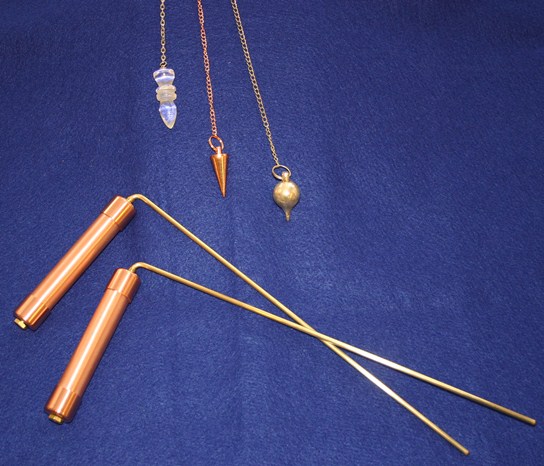
One of the most interesting yet scientifically unverified forms of divination known to occultists is dowsing. Put simply, it is the unconventional quest of seeking lost objects, subterranean streams and tunnels, areas of geopathic stress, and subtle electromagnetic fields known as ley lines with a pair of metal rods. Anybody can construct these by dismantling metal coat hangers and refashioning them to look like handguns. According to many dowsers, the ideal length for the production of a convenient set is a thirty-four inch rod bent to ninety degrees along the twenty-eight inch point. Each bifurcated rod should have two uneven ends, a shorter six-inch end to be used as a handle and a longer, twenty-eight inch one that plays the part of a sensor. Bending the arrowhead of each rod downwards is a recommended precaution if there are minors around.
Operating these beauts is child’s play. Begin by holding them out in front of you, one in each hand. It doesn’t really matter whether they’re proportionally aligned and pointing forwards or whether they’re at odds with one another because their reaction to any positive physical force will be both instantaneous and unanimous. Whatever your preference, make sure the grip you adopt is tenuous as to enable the rods to swing freely about the minute they detect something. Once you’ve determined what you wish to search for, scour the area by pivoting or simply taking a casual step forwards. Remember to keep your hands as steady as possible to thwart any unconscious somatic influence on your part. Both metal rods will swing in one direction when the object or feature is detected, revealing the general area in which you should concentrate your quest. There’s usually little to no chance of a misreading because reactions are usually quite potent; one can easily tell the difference between rods that are being manipulated somatically and ones whose automatic movements require alternative or more extraordinary explanations. The best method of pinning down the exact coordinates for lost items and features whose origin is unknown is to take measurements from variant points of reference; your missing item or unknown feature is more than likely waiting for you at the intersection of those lines.
Dowsing rods work for some people and for others they don’t. We know this because results obtained through experimental trials can be replicated innumerable times over. The reason/s for this incongruity is unknown and there have been no empirical studies conducted attempting to link one’s somatic or psychological makeup with an ability to elicit responses from detector rods. Furthermore for those who can get the rods to work, success is contingent on the availability of the object or feature in question. Those which cannot be retrieved or located due to colossal or impenetrable distances will give erratic or contradictory readings.
My recent experimentations with dowsing rods garnered some interesting results. Firstly, they could only accurately identify objects or features whose coordinates were known to me on a conscious or subconscious level. When I had my brother hide objects about the house without my knowing their location, the dowsing rods gave readings that were inconsistent. Moreover it seems that constricting the field of vision or eradicating it altogether by blindfolding the dowser results radically disables the rods’ perspicacity in finding items. Thirdly, my ability to initiate movement diminished drastically when I was mentally and/or physically exhausted; on some occasions, they didn’t move at all.
From these observations, I was forced to conclude that the phenomenon in question can be explained away quite rationally. Charged by the unconscious will of the dowser, the metallic rods could be thought of as a subtle pair of “antennae” which remember the positions of things forgotten by the personal conscious. In other words the instigator of the atypical movement is the unconscious mind. When one’s usual “psychic” power or vitality is reduced–either through mental exhaustion, physical exhaustion, or a combination of the two–or when the visual modality responsible for gathering information on cardinal orientation is impaired, the ability to affect matter is either hampered considerably or rendered defunct. These reflections lend further credibility to the mind-affects-matter hypothesis.
Sometimes, the temptation to look for “psychic” or paranormal explanations to elucidate phenomena can be overwhelming although these should never be entertained without exhausting the conventional “scientific” possibilities first.
Click on the link below to watch the video component:
The “Mind Machine” Experiments by Dr. Paul Kiritsis – Dowsing Rods








